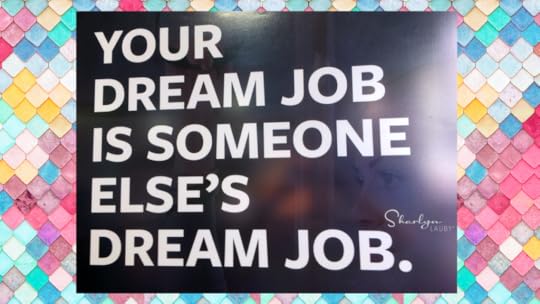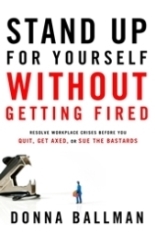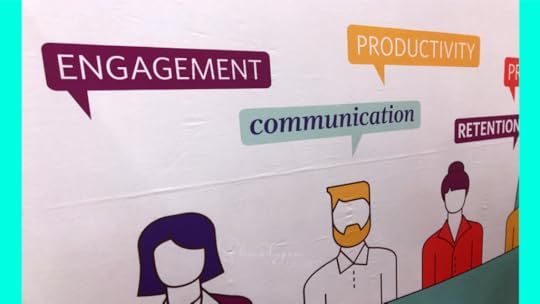Sharlyn J. Lauby's Blog, page 84
April 16, 2020
A Tribute to Chris Fields @ResumeCrusade

Over the weekend, I heard the news that Chris Fields passed away. Chris was the owner of ResumeCrusade.com and the content manager for PerformanceICreate.com
Chris loved his family and friends. He was a fan of Prince’s music and the Ohio State Buckeyes. He was an advocate for great HR and a friend to me and many others. I know the world is a little less bright without him.
I found myself this weekend spending some time reading a few of the articles that Chris and I worked on together. He was a fabulous friend to HR Bartender and very willing to share his knowledge and expertise with us. As a tribute to him, I wanted to share with you some of the articles we worked on together and the astute things he said about job search. I think you’ll find his words of wisdom valuable.
How to Address Being “Forced Out” During a Job Interview
“If you’re negotiating a separation package or exit strategy, I would suggest asking for a non-disclosure agreement so the reason for the resignation never comes out. This way the employee can create the narrative that best fits them as they look for new work.”
How to Find the Right Resume Writer
“I always tell people to vet your resume writer carefully. Have a conversation with them and, if they are unwilling to speak to you, that’s not a good sign for sure. Three things that someone might want to ask a resume writer include:
What’s the process?Do you have any testimonials or ‘real people’ that can verify your work?Can I see examples of your work?”
What Job Title Should I Use on My Resume?

“Let’s talk about tweaking job titles. You may think I’m going to say ‘no’ to this one but I’m not. It depends. The first rule to tweaking job titles is to never tweak upward, meaning don’t change or tweak your title to a bigger position. So basically, don’t give yourself a promotion. However, if you are listed as an office coordinator or assistant, it’s okay to use administrative assistant, because they are the same thing – same duties.”
Does Providing References Mean You’ve Got the Job?
“If asked for your references, you should absolutely take that as a good sign. You’re probably a finalist. However, you should not assume you have the job. I often tell my resume clients, ‘You don’t have job until you have an official offer.’ That means until they call and negotiate salary and benefits, there is no deal!”
“No two resumes should be the same. You can say the same thing 10,000 ways, so, I would rephrase my resume and maybe add a detail or two that is specific but different from the plagiarized resume.”
“Companies choose the wrong person all the time and end up calling other candidates once they have realized the error, so why can’t you? Just tell them honestly, ‘It seems I made a mistake, and I am wondering if there is still an opportunity with your company.’ You want to be sincere as possible. So, if you have a point of contact name and phone number, call them and explain the situation.”
Words cannot begin to express how grateful I am to Chris Fields for his friendship and unselfishness. Cheers my friend. Cheers to you.
Image captured by Sharlyn Lauby at the 34th Street Graffiti Wall in Gainesville, FL
The post A Tribute to Chris Fields @ResumeCrusade appeared first on hr bartender.






April 14, 2020
Mandatory Employee Handouts are Required At the Federal, State and Local Levels

(Editor’s Note: Today’s article is brought to you by our friends at Poster Guard® Compliance Protection, a division of ComplyRight and the leading labor law poster service that gets your business up to date with all required federal, state and local labor law postings, and then keeps it that way — for an entire year. Enjoy the article!)
Most, if not all, employers know that they need to have labor law posters. But did you know that in addition to posters, employers are required to provide handouts.
Handouts are similar to labor law postings because they are mandatory legal notices informing employees of their rights. There are two primary events that require handouts:
New Hire handouts are required when someone is hired or rehired. Common examples would be notices regarding wages, harassment, sick leave, and health insurance.
Employee Event handouts are required when an employee has a qualifying event take place. For instance, when an employee requests a leave of absence, if a workplace injury happens, or at the time of termination.
Mandatory employee handouts are required at the federal, state, and local level.
On a federal level, there are up to 15 mandatory handouts. Common examples include Consolidated Omnibus Budget Reconciliation Act (COBRA) general and election notices, premium assistance under Medicaid and the Children’s Health Insurance Program (CHIP), and the tip credit notice for employees in that wage group. There is also a new notice that covered employers must provide to all new hires under the Families First Coronavirus Response Act (FFCRA).
At the state level, there could be up to 23 additional handouts depending on the state. For example, in California, new hires must receive a notice on the rights of victims of domestic violence, sexual assault and stalking, among others.
Local requirements are on the rise. There are dozens of requirements in place today, and new ones being issued regularly. In Florida, there are at least two local handout requirements. In St. Petersburg, employees are required to receive a wage theft notice (as well as in Pinellas County).
What makes compliance with mandatory employee handouts challenging is that distribution options vary by handout because each underlying law is different. Some of them need to be signed or acknowledged by the employee. Here are the five most common ways that handouts may be distributed (depending on the applicable law).
Print and physically hand out. Many times, this happens during orientation.
Send via email.
Include in a policy manual like an employee handbook.
Include with paychecks.
Post electronically on the company intranet (provided the company has an intranet used to communicate policies to all employees).
Of course, there are penalties and fines for non-compliance. And this doesn’t include the ill-will and breakdown of trust this can create with employees when they discover that they should have been notified about something (and they weren’t).
Now, I get it. You might be saying to yourself, “I already knew this.” Or “No, big deal. I’ll just download them.” And that’s where the second challenge lies. There is no one-stop government website to find and print these handouts. Organizations are on their own. This involves a lot of time for HR departments to research and stay on top of handout requirements. Time that you could use on other things like employee engagement, retention strategies, etc.

I asked Ashley Kaplan, Esquire, senior employment attorney for ComplyRight, for a realistic look at the scope of work for HR departments to maintain compliance in this area. “For companies that operate in multiple states, obtaining the proper notifications is particularly burdensome given that there are more than 400 notices nationwide, and they change frequently (on average, 50 changes nationwide per year). Many of the handouts have to be created internally because the government doesn’t provide model notices to use.”
However, there’s another answer. Instead of taking on this project internally, organizations can partner with someone who specializes in this activity. The Mandatory Employee Handout Service brought to you by the same attorneys behind Poster Guard Compliance Protection, was developed to provide companies with all mandatory employee notifications at a federal, state, city, and county level. The service also includes instructions for each handout to help organizations distribute the handouts in compliance with the law. In my opinion, this is a no brainer. As a human resources professional, I should not be spending my time right now searching websites. I should be using my time engaging workers and making sure that employees know the organization supports them.
No question that compliance is an important part of human resources. But this doesn’t mean that compliance has to be the majority of what HR does. We can find strategic partners to help manage organizational compliance.
If you want to learn more about the Poster Guard mandatory employee handout service, be sure to check out the details on their website. I think you’ll find it worth your time.
The post Mandatory Employee Handouts are Required At the Federal, State and Local Levels appeared first on hr bartender.






April 12, 2020
Looking For a New Job With a Non-Compete Agreement – Ask #HR Bartender

Late last year, I shared with you the “5 Key Components of a Non-Disclosure Agreement”. It’s an interesting read if you’ve ever been asked to sign one, especially in today’s labor market. This reader note doesn’t deal with non-disclosures, but something similar: non-compete agreements.
Hello Sharlyn. My question is simply this: sometime during my wife’s 21+ years with a company she was asked, and did sign, a non-solicitation / non-compete agreement. She was recently let go, told due to company cutbacks. As she has been in this industry for over 21 years and the company let her go, it is my belief that the non-solicitation / non-compete agreements are now invalid as my wife was not the one asking to leave, and it is her line of work to be gainfully employed. Am I wrong? Is there a situation where she could be held to it?
To offer some insights about these types of agreements, I asked employment attorney Donna Ballman to share her expertise. She’s helped us before with one of my favorite posts titled, “Can You Bring Your Mother to a Meeting With HR?” Donna’s work focuses on employee-side employment law issues, so whether you’re an employee or an HR pro, these insights will prove to be valuable.
Please remember that Donna’s comments should not be construed as legal advice or as pertaining to any specific factual situations. If you have detailed questions, they should be addressed directly with your friendly neighborhood employment law and labor attorney.
Donna, obviously we don’t know all of the details, but it would be good to talk about non-solicitation and non-compete agreements. Let’s start with some definitions. What’s a non-solicitation agreement and a non-compete agreement? Because it’s my understanding they’re not the same thing.
[Ballman] A non-solicitation agreement is one saying you won’t solicit the employer’s customers and/or employees for a set period of time. A non-compete agreement says you won’t work for a competitor for a set period of time. That period can be from weeks to years.
In your experience, why do organizations ask employees to sign these types of agreements? And are there situations when an agreement is unenforceable?

[Ballman] Well, there are two different answers. What they’re supposed to be for is to protect legitimate interests such as trade secrets, company goodwill, or other interests, as defined state by state, but never for the purpose of preventing competition.
An agreement solely for the purpose of preventing competition violates antitrust laws. Yet many employers use them for improper purposes, such as preventing competition, suppressing wages, or forcing employees to work in abusive situations.
I can see the benefit to employers in having an employee sign these types of agreements. But, is there any benefit to an employee? If so, what is it?
[Ballman] I can’t think of one, but many states allow employers to spring them on employees after they start and say sign or be fired. So, most employees feel they have no choice but to sign if they want to keep their jobs.
This reader’s note talks about his wife wanting to be “gainfully employed”, so let’s focus on the non-compete aspect. Do the circumstances of an employee’s departure (i.e. a layoff versus a termination) effect a non-compete agreement?
[Ballman] In some states yes, in others no. I can speak to very anti-employee Florida, where the statute specifically says a court cannot consider hardship on an employee.
But in some states that are more employee-friendly, a termination without cause may limit a non-compete agreement’s enforceability. Some may require a severance payment for the length of the non-compete. Some states bar some or most non-competes.
If an employee is concerned that they will not be able to find work after signing a non-compete, do they have any options? If so, what might they be?

[Ballman] Let’s assume that hardship is not a defense in your state. I tell my clients to try to look for a sidestep. For instance, if your company manufactures widgets, maybe go to a company that distributes widgets. Or go to a company that manufactures something else, say sprockets.
Maybe your restriction is in one county, but you can work in the next county over. Look carefully at your restrictions and see if there is something you’re allowed to do that would keep you in your industry but allow you to still comply with the agreement.
Last question. Regardless of the circumstances of an employee’s departure (i.e. voluntary or involuntary termination), should employees always ask to be let out of their non-compete agreement? I mean, is there harm in asking?
[Ballman] I always recommend trying to negotiate with the employer. For instance, say you’re in doubt about whether the sprocket manufacturer is something the company would consider a competitor. I usually say send something like this with a read receipt and a delivery receipt: ‘I have an offer from ABC Sprockets. They do not manufacture widgets, and I believe accepting this position will not be a violation of my confidentiality and non-competition agreement. If you disagree with me, please notify me within 72 hours from the date of this email. Otherwise, I will accept the offer.’ Then one of several things will happen.
They’ll say ‘Okay, that’s fine’. Great! Go ahead and accept. If they didn’t put that in writing, then you put it in writing. ‘This will confirm our conversation on June 17 that you agree ABC Sprockets is not a competitor and that I am free to accept a position with them.’
They say ‘No’. We’ll sue you, your mother, your dog, and everyone you ever met if you take this job.’ That’s the time to hire someone like me who handles employee-side employment law in your state to respond and explain why they think there’s no legitimate interest to protect and try to negotiate for you.
They ignore you. Then send another email saying something like, ‘I am glad you agree that I am allowed to accept this position. I will notify them of my acceptance.’ Then wait another 24 hours or so to see if they surface. If they don’t, send your acceptance, make sure the job is confirmed, then send your resignation.
Does this make the whole issue go away? Not necessarily, but lack of good faith is a defense to enforcing a non-compete or non-solicitation agreement, so this could help if it came to proving your case. I actually had a case where the former employer said okay, threw my guy a farewell party, told everyone where he was going, then sued. We still had to defend him (and successfully, I might add).
If you have a good relationship with the employer, it doesn’t have to be this formal, but if you do verbally negotiate release or reduction of your non-compete or non-solicitation agreement, follow up in writing. Your agreement probably says it can only be modified in writing signed by both parties.
My thanks to Donna for sharing her knowledge with us on this tricky topic. Please be sure to check out her blog, Screw You Guys, I’m Going Home. It’s been named one of the American Bar Association’s 100 best legal blogs. And she’s the author of the award-winning book “Stand Up for Yourself Without Getting Fired: Resolve Workplace Crises Before You Quit, Get Axed or Sue the Bastards.”
As more employees are faced with initiating a job search, it’s important to understand all of those documents you signed as an employee. This will allow you to focus your energies in the right direction.
Image captured by Sharlyn Lauby while exploring the streets of Long Beach, CA
The post Looking For a New Job With a Non-Compete Agreement – Ask #HR Bartender appeared first on hr bartender.






April 9, 2020
Give Employees a Career Development Manual

A couple of years ago, I wrote an article titled “Create a Personal User Manual So Others Know How to Work with You”. I think it’s a great onboarding activity for managers and new employees to start building positive working relationships.
At last year’s Qualtrics X4 Experience Management Summit, I heard about another kind of manual that organizations should consider giving their employees. This one is focused on career development and how to get a promotion – a career development manual. Dan Spaulding, chief people officer at Zillow Group, a leading real estate and rental marketplace, was sharing with attendees how Zillow is in a growth mode and they want to make sure their talent pipeline is ready for future opportunities.
Even if your organization isn’t in a growth mode, giving employees clear expectations regarding what it takes to get a promotion or pursue a specific career path is the right thing to do. Spaulding shared that there were three elements to getting a promotion/new opportunity at Zillow.
Individual Readiness + Job Scope + Business Need = New Job!!
This makes total sense to me. The company needs the position. The employee needs to be ready and capable to do the job. But here’s where it gets tricky. In many organizations, employees don’t have much control over business need.
Where employees do have control is their job scope and individual readiness. I tend to think of job scope has the employee’s ability to do their current job. And hopefully, employees are receiving regular feedback about their current job performance during performance reviews and one-on-one meetings with their manager.
The component of this promotion formula that I believe can get overlooked is individual readiness. And that’s why it could make some sense to give employees a career development manual. Individual readiness is one area where employees can take the lead in their own development. Here are some things to consider including in the manual:
General readiness skills that every employee should work on. No matter where you are in your career path, it’s always a good idea to focus on your listening skills, ways to become a better team player, opportunities to show genuine appreciation to others, proven strategies for getting the work done, and activities to stay current with the business. It also couldn’t hurt to encourage employees to deliver relevant feedback and be curious with technology. Those are just a few ideas. I’m sure you have some more that you can share with your team.
In addition to giving employees some ideas about skills and competencies they should develop; organizations can offer some suggestions about where they can learn. Let employees know where they can find organizational resources such as a business library, blogs, and sponsored webinars or podcasts. If the company offers a buddy or mentoring program, make sure employees know how to access it so they can start building connections. And finally, don’t forget to let employees know about training programs or special projects they can be considered for to add work experience.
All of these things – resources, experiences, and connections – allow employees to become ready for new opportunities. Organizations have a wonderful opportunity to create a career development manual they can share with new employees at some point during the onboarding process. It’s a good way to tell employees that the company hopes they will be around for a long time.
The post Give Employees a Career Development Manual appeared first on hr bartender.






April 7, 2020
How to Prepare Employees for Getting and Giving a 360 Feedback Review

(Editor’s Note: Today’s article is sponsored by Primalogik, a cloud-based performance management solution that provides a flexible way to manage employee reviews, 360-degree feedback, goals, and engagement surveys. Enjoy the read!)
I once worked with a sales manager who not only met but exceeded her goals. Every. Single. Time. The CEO thought she was fabulous. The director of sales said she was awesome. Employees came into my office and complained about her all the time. Maybe you’ve been in a similar situation. As HR professionals, we know that sometimes performance challenges emerge within the organization.
Obviously, once the source and the causes of the performance challenge are identified, the organization and individual can work together to fix it. But it takes specific tools to get us to that point.
A 360 feedback review (also known as a multi-rater review) helps paint the most complete picture of an employee’s overall performance and behavior at work. It provides clarity on what skills an employee might need to strengthen and the qualities they are most valued for according to their peers, direct reports, managers, and other colleagues.
What makes a 360 unique and valuable is the opportunity to solicit feedback from a diverse group.
Now I don’t want anyone to think that 360 reviews are exclusively focused on problem employees so let me share another story. I consulted with a CEO who felt so strongly about getting feedback that he would receive a 360 feedback review every year which he considered both his performance review as well as his feedback for his executive development. What makes a 360 unique and valuable is the opportunity to solicit feedback from a diverse group.
Give Employees the Tools to Offer Good Feedback
As organizations look to develop talent from within the organization, a 360 feedback review can provide valuable insights. But before implementing a 360 feedback program, it’s important to prepare employees for the change. A 360 feedback review is different. There are two types of changes that are taking place. The first is that an employee will receive feedback from multiple individuals via the 360 review. The second is that employees are responsible for providing feedback to others.
Let’s talk about the latter first because sadly, I believe organizations often forget this part. For 360 reviews to be successful, the individuals involved need to know how to give good feedback. It takes high degrees of trust among colleagues and management. HR departments will be tasked with making sure all employees receive the training necessary to deliver relevant, valuable performance feedback.
In addition, there needs to be assurances that the feedback provided to the individual will be presented anonymously. Sometimes subordinates and colleagues are intimidated at the notion of providing critical feedback because they are concerned about how their feedback will impact working relationships, merit increases, and promotional opportunities. Anonymous feedback will allow employees to provide honest, candid feedback so everyone can feel comfortable.
Finally, the last component to help employees give good feedback is to use language and terminology that respondents will understand. HR departments will want to work with their testing partner to ensure the feedback items are crafted well. For example, instead of saying “What is the favorability of your workplace environment?” just ask “Do you enjoy your workspace?”
Support Employee Emotions in Receiving Feedback
As I mentioned earlier, one of the main reasons that organizations use 360 feedback reviews is so employees can receive feedback about their performance. And they need to be ready to hear the results.
Let employees know the WIIFM (What’s in it for me?) associated with the process. A 360 feedback review can provide a more objective understanding of their performance behaviors because it reduces bias. In a traditional performance review, the feedback we receive can sometimes be subjective because it’s only coming from one person (i.e. our boss) and it’s often focused on performance outcomes. The 360 feedback process brings together a diverse range of viewpoints from around the organization and shows the employee where they excel and where they might want to improve. It actually provides a better understanding of overall performance than a single person review could ever provide.

Once an employee receives their feedback data, they should be given time to review and digest it. The manager and employee can work together to produce a plan that allows the employee to further develop their strengths and improve weaknesses. Again, it’s important to reiterate that a 360 feedback review is designed to do both. Managers should then schedule regular follow-up meetings with employees to ensure they’re making progress with their development plan.
360 Feedback Reviews Can Provide Performance Insights
The 360 feedback review process helps employees, managers, and organizations focus holistically on performance and performance behaviors. But the implementation takes some preparation both in terms of making sure that employees give relevant feedback and are prepared to receive current, valuable feedback.
If you want to learn more about 360 feedback reviews, be sure to check out the Primalogik blog and request a demo.
The post How to Prepare Employees for Getting and Giving a 360 Feedback Review appeared first on hr bartender.






April 5, 2020
Someone Plagiarized My Resume – Ask #HR Bartender

I must admit that today’s reader note was a first for me. I’m not questioning the reader’s legitimacy, but who steals from someone else’s resume?
Have you ever written about someone stealing the information on a resume word for word? Just happened to my niece by the guy who took the role she left 2 years ago for her current opportunity. The ‘stolen’ parts are her overview at the top of her resume as well as her accomplishments while serving in that role. One specific example is she improved several processes, saving 11% of the budget and won an award for doing so. He went as far as to claim that specific accomplishment (however removed the notation of the award) as well as several others not listed as part of the job summary. Not to mention, the formatting is awfully similar. If you’ve ever addressed it, please let me know. I’m not sure what advice to give her. While it won’t matter now, they live near each other, have similar backgrounds, and may compete for a role in government in the future.
Obviously, we don’t have all the specifics here, but this is really mind boggling. Because there are so many moving parts to the story, I asked some of our friends if they would share their thoughts.
Being the litigious society that we are, the first person I reached out to was our friend, Heather Bussing. She is an employment attorney and regular contributor at HR Examiner.
Heather, I know we don’t have the two resumes to compare but is taking parts of someone else’s resume a legal issue, an ethical issue, or both?

[Bussing] Copying text verbatim from someone else’s resume is probably not illegal. There may be some copyright claim, but if the information copied is factual and accurate, it would be hard to make a case that it was covered by copyright since facts are generally not copyrightable. The wording may be, but there are exceptions that could apply (I won’t bore you with a treatise on copyright law). And it’s hard to imagine what the damages would be at this point.
The real issue is if they were both applying to the same employer and the employer noticed the identical wording and wondered who was the one who copied. The easiest way to deal with that is for the reader’s niece to simply rewrite the text on her resume. This is not fair, and she should not have to, but it’s far easier and less expensive than trying to force the copier to fix his resume.
As for ethics, copying someone’s resume and using it for your own is a total weasel move. At best, it shows lack of imagination. It definitely demonstrates laziness and a tendency to take credit for other people’s work. But turning to the legal system is not going to be worth the time, energy, or expense on this one.
Thanks Heather! The second thing that crossed my mind was should the reader confront the person who “stole” the text. Hannah Morgan (aka Career Sherpa) is a well-known career strategist and a regular contributor at U.S. News & World Report.
Hannah, I’m not sure how this reader found out that pieces of her resume were ‘stolen’ and included on someone else’s. What are the pros/cons of confronting the person who supposedly copied the content?

[Morgan] To discover that someone has plagiarized your resume and taken credit for something they didn’t do must be aggravating. Here’s what I suggest she considers before taking any action.
Does it really matter? LinkedIn is almost more important than a resume today. Plus, if she updates her profile and the person copy’s that, she has more evidence to support her plagiarism claim since it’s out in the public.
The upside to confronting the person who has plagiarized her resume is that she will have the satisfaction of calling him out for both plagiarizing and lying on his resume. The downside to addressing this issue is that he could get angry and take revenge. But even if she does confront him, there’s no guarantee that he’ll fix the resume. If he had no problem doing it in the first place, he’s likely to do it again.
I would suggest she move forward and focus on controlling what she can control. That means updating her resume, which probably needs updating anyway and really personalizing her LinkedIn profile.
As Hannah mentioned, focus on those things you can control – being your resume. I spoke to Chris Fields, an expert resume writer and job search strategist over at Resume Crusade.
Chris, resumes are very personal documents. And I agree with the comments so far that this reader really shouldn’t have to change their resume because someone else copied from it. But are there some things they could do to bring back the uniqueness to their resume?

[Fields] I have had clients tell me about someone else’s resume before – even had people share with me someone else’s resume. Sad to say, there is a lot of spying happening out there. This reader could have found out by several means – he could have posted his resume online or LinkedIn.
I agree that resumes are personal documents, or they should be. However, I have been hired by people, usually couples or friends, and obviously they used the same resume writer previously, and that resume writer simply copied and pasted lines from one resume to the other. I recall two women who worked at the same company, in the same department, with the same job titles who were laid off and hired me to makeover their resumes. When they sent the old resumes to me, it was apparent that the old resume writer literally copied and pasted the same duties in the same order – verbatim. Seriously the top half of each was the exact same (SMH).
No two resumes should be the same. I have completed outplacement services deals where there were 10 employees, some in the same department and same titles, others in similar departments and after talking to each, although they did the same work, they went about it differently. So, none of those resumes were identical.
My suggestion to the ‘victim’ in this scenario is this: You can say the same thing 10,000 ways, so, I would rephrase my resume and maybe add a detail or two that is specific but different from the plagiarized resume.
I like Chris’ comment about specificity. This made me reach out to Ed Han, who describes himself as a talent acquisition geek and a regular contributor to Job-Hunt.org.
Ed, I have no idea what industries and jobs we’re talking about here. But if a recruiter were to see some similarities in the resumes and ask about it, how should a candidate respond?

[Han] I think that the candidate – the one who is the victim of such theft – should go into detail about how she accomplished those feats with specific and detailed information about the history, how she came up with those solutions, etc.
Here’s the thing: when I review a resume and something doesn’t seem right, I always ask follow-up questions. The person who simply copied another resume isn’t normally clever enough to concoct a plausible story around the history of the idea. A former recruiting manager I used to work for gave me an example that illustrates the point quite well.
Let’s say I enjoy craft beer and am discussing the subject with someone who purports to be knowledgeable about craft beer. They should be able to describe for me the difference between top and bottom fermenting beers, speak knowledgeably about IBUs (international bitterness units), the Bavarian beer purity laws of several centuries ago, and what various different types of hops do for the flavor. Someone lacking the desired knowledge can’t fake that.
That’s how I would discern who’s telling the truth and who isn’t.
I want to extend a huge thanks to Ed, Chris, Hannah, and Heather for sharing their experience with us. Especially during these challenging times. We’re so fortunate to have colleagues who are willing to help the HR community.
If you have any questions – and they don’t have to be as unique as this one – please let us know. You can just send us a note via our contact page. We’ll try to get you some answers.
Image captured by Sharlyn Lauby after speaking at the SHRM Annual Conference in Las Vegas, NV
The post Someone Plagiarized My Resume – Ask #HR Bartender appeared first on hr bartender.






April 2, 2020
Managers: How to Support Remote Employees – Ask #HR Bartender

Last week, we provided a list of resources to help individuals get adjusted to working from home. After it was published, I received this note.
Dear HR Bartender! I’m a loyal and excited reader of your blog and usually find very great tricks and tips I can experiment with at my workplace. Currently, I work as an HR generalist in a team of 2, taking care of 110 employees. It’s always been our main focus to take care of employees by providing regular career feedbacks, mood boosting events, and just being around (literally) to chat. Like many organizations, we have moved to working from home due to COVID-19 and it’s very new to us. I was wondering if you have any practical tips and tricks how to lift employee spirits from a distance and how to take care of those who might not take this situation well? I would love to read an article on that! Thanks.
First, thanks so much for the very kind comment. We try our best to be a good resource to all managers and HR professionals. It’s always great to hear this kind of feedback.
Now, this is a really great question! Some people might feel that working from home can negatively impact company culture and employee disengagement. I won’t lie – it might if the organization doesn’t make the effort to engage with employees. But in many cases, this work arrangement is an opportunity. Here are two things to consider during this time of remote employees working from home and sheltering in place.
Give remote employees the tools they need to get work done
Think of this situation in two parts. First, employees need resources to do their jobs. That might be technology, software, office supplies, etc. Basically, they need the stuff that the office environment provides. I’ve heard of companies allowing employees to take computer equipment home. Managers should check-in with employees to make sure that they have the things they need. And if they don’t, maybe the company can give them a small stipend to buy some office supplies online. Or someone can put together some office supply boxes and send them to employees. Bottom-line: figure out how to give remote employees the things they need to work and use it as an opportunity for engagement.
I’m sure some of you are saying, “Really? All we need to do is give employees staples and paperclips?!” And for some employees the answer is “yes”. Under normal circumstances, remote employees get time to put an office together. COVID-19 forced us to make fast decisions and employees didn’t get time to prepare. Don’t forget rule number 32 from the movie “Zombieland” – enjoy the little things. It will help you keep your sanity. And the engagement of your team.
But really when I refer to tools and resources, the big one on the list is technology. Some employees might not have desktop computers at home. They might not have WiFi. And if they do, their technology and internet might not be the latest and fastest. Not like at work. I’ve mentioned before that there are studies indicating if employees have to spend a lot of time creating workarounds because they don’t have the best technology, this can contribute to stress and burnout.
Support remote workers’ well-being
The second part has to do with emotional support. Speaking from personal experience, when you work from home, you’re disconnected. Some of your employees are going to love that. Others…not so much. Managers need to set up time to chat with remote employees – about work projects of course, but also just a “how are you doing?” and “what can I do to support you?” In many office environments, this happens in small 5-minute chats throughout the day. Now it’s going to have to be a little more intentional.
Encourage employees during this time to take care of themselves. Let employees know that you understand the challenges they’re facing. Families are spending all day together. Let that sink in for a moment. Employees are working and home-schooling their children. They can’t see parents or grandparents. No birthday parties or anniversaries. It’s possible we will spend religious holidays like Easter and Passover – traditionally extended family events – by ourselves. Maybe now is the time to create some (virtual) employee affinity groups.
I honestly don’t know that I have all of the answers here. You know who might? Your employees. Consider asking employees how HR can best support them during this time. HR could do training sessions over a platform like Zoom. This might be a perfect time to do some virtual lunch and learn sessions about social media or even manager development. Maybe have some “coffee chats” or create a book club.
The goal (and the challenge) is to be there enough that employees know you’re supporting them but not so much that all of the activities get in the way of the work. It’s a delicate balance for sure. Asking employees what they need – and they might not know right away – will help start the conversation. And it will engage the workforce by bringing them into your strategic planning.
Image capture by Sharlyn Lauby while exploring the streets of Austin, TX
The post Managers: How to Support Remote Employees – Ask #HR Bartender appeared first on hr bartender.






March 31, 2020
Remote Employees: Employement Law Posting Requirements

(Editor’s Note:
Today’s article is brought to you by
our friends at Poster Guard
, a division of ComplyRight and the
leading labor law poster service that gets your business up to date with all
required federal, state and local labor law postings, and then keeps it that
way — for an entire year. Enjoy the read!)
I know we’re seeing a
lot of articles today about being in unprecedented times. And frankly, that’s
because it’s true. Employees are working from home like never before. And
technology tools like Slack and Microsoft Teams are helping remote workers
collaborate on projects.
But this new normal raises
the question, “How do organizations communicate with employees when it comes to
topics like employment law compliance postings?” I know we need to be focused
on supporting our employees, along with productivity and the work, but we also
need to make sure all employees know their rights as required by federal, state,
and local law.
I spoke with Ashley
Kaplan, Esquire, senior employment law attorney for ComplyRight about this
issue. Ashley leads the expert legal team for Poster
Guard® Compliance Protection. On a personal note, I’ve known Ashley for years
and I’m thrilled to share her knowledge on the blog.
Please
remember that even though today’s post is sponsored, Ashley’s comments
shouldn’t be construed as legal advice or as pertaining to any specific factual
situations. If you have detailed questions, they should be addressed with your
friendly neighborhood labor and employment law attorney.
Ashley, before we talk about the specific posting requirements for
remote employees, it might be a good refresher to discuss, in general, the
current posting requirements for organizations.
[Kaplan] Sure. All employers must
post federal, state, county, and city (if applicable) postings. The mandatory
federal posters include:
Equal Employment Opportunity Commission
(EEOC) Occupational Safety and Health Act
(OSHA)Family and Medical Leave Act (FMLA)Uniformed Services Employment and
Reemployment Rights Act (USERRA)Fair Labor Standards Act (FLSA)Employee Polygraph Protection Act
(EPPA)
There is also a new temporary federal
poster required for employers with fewer than 500 employees under the Families
First Coronavirus Response Act. The
new poster summarizes the new emergency paid sick leave law, which remains in
effect until December 31, 2020.
In addition, there could be up to 15
additional state-specific posters, depending upon what state you’re in … and up
to 10 additional posters for city/county compliance. Oh, and don’t forget there
are additional posters for government contractors and certain industries. The
topics for these state, county, city, and industry-specific postings include minimum
wage, fair employment, paid time off, child labor, unemployment insurance,
workers’ compensation, expanded family/medical leave rights, smoking in the
workplace, electronic cigarettes, human trafficking, and more.
For HR pros who just read that list of
requirements and are saying to themselves, “I have no idea if I have the right
posters up!” is there a government site that will tell them everything they
need?
[Kaplan] Sadly, no.
The postings are issued by multiple different government agencies. Believe it
or not, HR professionals have to visit each agency’s site to find out posting
requirements. There are 175 different agencies responsible for issuing more
than 390 posters at the federal and state level. Add to that the approximately 22,000
local jurisdictions that have the authority to issue their own postings. That’s
a lot of follow-up and unfortunately, these agencies aren’t required to
coordinate efforts.
So potentially, HR pros have to check several
websites to make sure their organizations are in compliance. But do posters
really change that often?

[Kaplan]
Surprisingly, they do. Our Poster Guard
legal team monitors posting changes and has found that on average there are
approximately 150 state-specific poster changes per year, with half of them
requiring mandatory updates. This number started to increase significantly in
2018 as a result of all the newly enacted state and local employment laws. In 2019, we had a record number of mandatory
changes with almost 200 state and local changes. I’m sure that the big changes, like minimum
wage increases, most businesses are aware of. But businesses need to pay
attention to the small changes too because the government isn’t required to
notify businesses when those changes happen. Also, be aware that mandatory
posting changes are issued throughout the year, not just in January.
I honestly don’t remember labor law posters ever being
so complex. But, let’s shift the conversation to remote workers. With COVID-19
increasing the number of people who are working from home, how do current labor
law posting requirements impact remote workers?
[Kaplan] By law, you’re required to
provide these mandatory notices to ALL employees. That includes remote workers
such as employees who work from home, offsite, on the road, at mall kiosks, in
mobile service units, out in the field, and at construction checkpoints. With
the shift to remote work in response to the coronavirus pandemic, employers still
have to maintain posting compliance as new important posters are coming out
during this crisis on issues like emergency paid leave, unemployment and
disability benefits. This includes the new federal poster required under the Families
First Coronavirus Response Act.
Hopefully, this doesn’t mean that HR needs to send remote workers
full-size laminated posters to hang in their spare bedroom/home office?
[Kaplan] No, but it does mean that
employees need to receive notices. Although the regulations don’t specify the
format — paper or electronic — employers are responsible for communicating the
same information to your remote workers as those onsite. The U.S Department of
Labor (USDOL) has recently clarified that electronic postings are a compliant
solution for remote workers that have computer access. For employees who work
on computers as part of their jobs, we recommend electronic
delivery of postings, where workers can download, view and acknowledge receipt
of all required postings. This satisfies your obligation to communicate their
rights, as covered in the mandatory federal, state, and city/county postings.
We might be
venturing into new territory here, but what happens if an employee who was
working in an office (and saw the postings then) is working from home (where
they don’t see the postings now)?
[Kaplan] The law
isn’t 100 percent definitive on how frequently a remote employee must access
the physical wall posters to be covered.
However, FAQs published by the USDOL suggest that, if an employee
reports to a company’s physical location at least three to four times a month,
the physical postings at the business are adequate. If not, the DOL recommends
electronic delivery.

That raises another
question about what information should an employee receive. If a company has remote
employees who work in different states, which posting requirements should they follow?
Those from the state where the company is headquartered or the state where the
employee works?
[Kaplan] Unfortunately,
it’s not always clear which state laws apply in this instance. Most basic
employment rights — such as minimum wage, overtime and safety issues —
are governed by the laws where the employee performs the work. However,
depending on how your company is structured, your out-of-state employees may be
covered by both states’ laws. Because
it depends on so many factors, we recommend you provide both sets of
state-specific postings to remote workers in this situation.
Last question, there could be people thinking, “Labor law posters aren’t a big deal. No one is going to come inspect us right now. And if they do, we’ll just get a warning.” What’s the penalty for businesses who are not in compliance with this employment law?
[Kaplan]
Recently, the amount for federal posting fines increased to more than $35,000
per violation, per location. State and local fines range from $100 to $1000
each. But the real price tag comes in terms of lawsuits or investigations.
An agency could
be on-site for a number of reasons, such as an immigration issue, OSHA inspection,
wage and hour audit, or EEOC complaint. The first thing they will do is look
for up-to-date postings, and non-compliance can negatively impact the outcome
of the investigation.
The real danger
is with employment litigation. A missing or outdated posting can impact damages
and can even ‘toll’ or extend the statute of limitations. And as your readers
know, the statute of limitations can often be an employer’s best friend in
defending claims.
I would like to extend a HUGE thanks to Ashley for sharing her employment law expertise with us. If you want to learn more about how to make sure your posting requirements are up to date, I hope you’ll check out Poster Guard. Today’s technology makes providing remote workers with their postings easy. They also guarantee their work against government posting fines. Right now, they’re offering a special intranet licensing service to help organizations stay in compliance with their remote workforce during this national emergency.
According to Ashley, you can maintain labor law posting compliance during this time when many employees are working from home by giving employees digital access to the postings via your corporate intranet site or employee web portal. Employees would be able to click a link on your site and view applicable federal, state, and city/county notices.
I realize that our workplace “new normal” is changing all the time. I think that’s one of the reasons that compliance is so important. Whether employees work in the office or remotely, it’s comforting for them to know that the organization is doing the right thing and keeping them informed of their rights.
Image captured by Sharlyn Lauby while exploring the Wynwood Arts District in Miami, FL
The post Remote Employees: Employement Law Posting Requirements appeared first on hr bartender.






March 29, 2020
3 Workplace Articles Every Manager Should Read Right Now

(Editor’s Note: Today’s article is brought to you by
our friends at Kronos
, a leading
provider of workforce management and human capital management cloud solutions.
Be sure to check out the
Kronos
HR & Payroll eSymposium
scheduled for May 6, 2020 – a single day
of learning focused on pressing business issues. Enjoy the article!)
I don’t need to spend a lot of time explaining how workplace
norms are changing quickly and frequently. That means now, more than ever,
managers need and want resources to help them support their employees and do
their jobs more effectively.
The Workforce
Institute at Kronos is a think tank that helps organizations drive
performance by addressing human capital issues that affect both hourly and
salaried employees. Advisory board members – of which I’m one – regularly share
their experience and knowledge on the Workforce Institute blog. It’s a great
resource so I thought that I would put together a few articles you could share around
your organization.
The
Importance of Adaptive Leadership
Adaptive leadership is an important competency for leaders
at all levels of an organization. The ability to foster teamwork and
collaboration has a direct influence on the relationships between team members
and, as a consequence, on the company’s organizational climate.
Communicating
in a Multigenerational Workplace
Communicating with people in general can be a challenge, but
multigenerational communication is a whole new ball game. One of the most
interesting aspects of work – and sometimes one of the most challenging – is learning
how to communicate appropriately with colleagues who span generations.
Upping
Your Employee Feedback Game
As a manager, you know feedback is the key to developing
employees and boosting their motivation and productivity. In study after study,
people say they want to receive it from their managers. And as a manager, you
know you need to do (more of) it. Most
of your employees are doing praiseworthy things every day. Look for them.
Organizations always rely on frontline managers to keep the
business running. So, giving managers resources to make them more effective is
a good thing. Even more so, during times when managers and employees are working
remotely. It
helps to keep the team engaged and involved. Supporting and helping our
workforce is the right thing to do.
The post 3 Workplace Articles Every Manager Should Read Right Now appeared first on hr bartender.






March 26, 2020
Bookmark This! Effective Business Meetings Edition

Before I start with today’s article, I wanted to take a moment to thank everyone for reading HR Bartender given everything that’s going on right now in the world. I know that for many of us, our work and home lives have been completely disrupted. Mr. Bartender and I are hoping that we can continue to provide you with resources to make your work lives a little easier and more productive. If you have questions or suggestions, please let us know . Be safe out there!
Some of the people reading today’s message are doing it
while working from home. Others might be at their work location, but half of
their co-workers are working from home. Regardless of your situation, chances
are that at some point, someone is going to say, “We need to meet about that.”
Business meetings are hard. They can be even more difficult when they’re virtual. Here are a few resources to help you have the best business meetings possible.
The
Only 3 Reasons to Hold a Business Meeting
As a general
rule, people do not complain when the reason for scheduling a meeting is legit.
They will always complain if a meeting was called and it could have been handled
with an email. One of the best skills to have as a working professional is the
ability to run a good business meeting. The first step is knowing when to call
the meeting.
Sometimes the phrase “let’s meet about this” sounds so
casual that it might send the message that meetings are easy. Truth be told,
meetings are hard work. The real key to a successful meeting is planning. If
you really take the time to plan and prepare, it has a definite impact on the
outcome of the meeting.
3
Signs You’re Not Talking Enough in Meetings (And How to Stop Being That Person)
When you’re
invited to a meeting, it’s because people want you to share your thoughts. Just
because someone is talking a lot is no excuse not to participate. If you don’t
talk at meetings you could be sending the wrong message – such as you don’t
have anything to contribute, you don’t care about the outcome, or you simply
agree with everything in the conversation.
A
Manager’s Guide to Successful 1:1 Meetings with Employees
The perfect one-on-one meeting is casual and conversational.
It’s also consistent, and that consistency brings trust and preparedness. To
help managers prepare for their next one-on-one meeting, bookmark this page and
share it around your office. Also, download the employee feedback and coaching
templates to use as a conversation guide.
How
to Conduct a Learning Session During a 1:1 Meeting
Learning conversations do not have to involve platform
skills and a bunch of fancy props. Rather, they simply require teaching
managers how to structure and deliver effective 1:1 meetings. This 5-step
method is an ideal activity to include in the company’s management development
or manager onboarding program.
An
Employee’s Guide to Successful 1:1 Meetings with Your Manager
Many organizations already train and coach managers on how
to conduct a one-on-one meeting. Organizations should make the investment and
do the same for employees. After all, they’re one-half of the 1:1 meeting and
need to take responsibility for their side of the conversation.
SMART-ly
Tracking Your Meeting Progress
Documenting what
occurs during the meeting is essential. The way meetings are recorded can have
an impact on the outcome of the meeting. Using the SMART plan for meeting
minutes also helps direct conversations toward key discussions like “We have a
great idea here…now who’s going to take ownership for getting it done?”
Meetings are always going to always be a part of business, whether they’re in person or virtual. It’s important that we respect people’s time and conduct good meetings. Employees will appreciate us for it. And the business will get more done.
Image capture by Sharlyn Lauby after speaking at the SHRM Annual Conference in Las Vegas, NV
The post Bookmark This! Effective Business Meetings Edition appeared first on hr bartender.






Sharlyn J. Lauby's Blog
- Sharlyn J. Lauby's profile
- 10 followers



